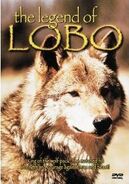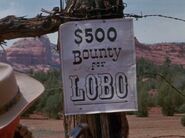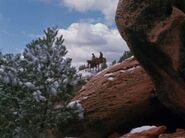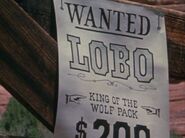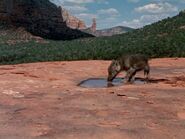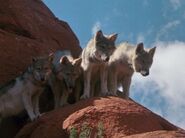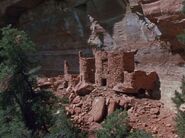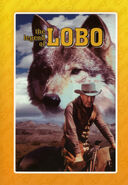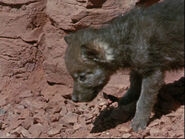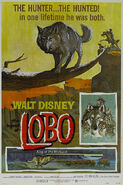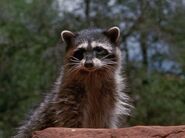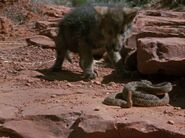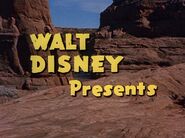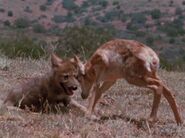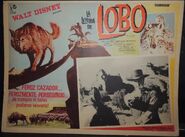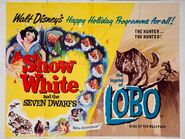The Legend of Lobo is a 1962 American film that follows the life and adventures of Lobo, a wolf born and raised in southwestern North America, loosely adapted from the historical wolf of the same name featured in Ernest Thompson Seton's book Wild Animals I Have Known. Neither time period nor precise location are specified in the film, in part because the story is told as much from a wolf's point of view as from a human's. There is no dialogue in the film; the only interpretation is through a story-song composed by the Sherman Brothers and sung by the Sons of the Pioneers, and narration by Rex Allen. Filming took place in Sedona, AZ.
Plot[]
The film begins when Lobo is a 6-week old pup, identical to his brothers and sisters. While his father is out hunting for meat to feed the family, Lobo follows his nose to his first adventure, and takes a tumble down the cliff his family dens in. As soon as he manages to climb back up, a cougar appears on the scene. Things look grim for the wolves, until "a wild card" shows up; cattlemen riding by below the wolves' den spot the cougar, and shoot it as it prepares to pounce on the wolves. The narrator makes it clear that the cattlemen do not favor the wolves: Lobo is only spared because he's out of sight. When Lobo's father returns to the den soon after the incident, he smells both the cougar and the cattlemen, and decides to pick up and move house to avoid them.
As Lobo travels with his family in search of a new den, they interact with a variety of creatures. His father fights with a badger over possession of a den, and the badger wins after an excellent show. At some point Lobo wanders off as his family moves on; he makes friends with a tortoise, chews an armadillo's ear, and is cornered by a rattlesnake when his parents finally arrive to rescue him. As Lobo begins to grow up, he also forms an unusual friendship with a young antelope.
When Lobo is 6 months old, he starts to hunt with the family pack. But rather than buffalo, the wolves' prey are the herds of cattle being driven across the desert. The cattlemen seek revenge on the wolves, and eventually kill several of Lobo's family pack. Winter comes, and Lobo branches off on his own for the first time.
In spring, Lobo joins a new pack, defeats its leader, and takes a mate. He and his pack continue to prey on the cattle that have replaced the buffalo, but is wise enough to avoid all signs of the angry cattlemen who post rewards for his capture - or his death. When the time comes for his pack to split up to mate and raise their pups, Lobo and his mate find a uniquely secure den in an abandoned dwelling that is accessible only by a precarious bridge.
As Lobo continues to feed on their property, the cattlemen's feud with him escalates. A professional hunter sets a trap for Lobo, but captures his mate instead, and Lobo musters his pack to rescue her. In spite of the victory, Lobo realizes the same thing his father did: humankind has encroached too far on the territory that used to be his, and his best course of action is to seek a new home. The film ends as Lobo and his pack race across the plains in search of a new home.
Cast[]
- Lobo as Himself
- Émile Genest as Cattleman 1
- Walter Pidgeon as Cattleman 2
- Rex Allen as Narrator
- Sons of the Pioneers as Themselves
Details[]
- Directed by James Algar, Jack Couffer
- Produced by Walt Disney, James Algar, Jack Couffer
- Written by James Algar, Dwight Hauser, Ernest Thompson Seton (wrote the novel)
- Starring: Walter Pidgeon, Gilles Payant, Émile Genest
- Music by Evelyn Kennedy (music editor), The Sons of the Pioneers (background vocals)
- Walter Sheets (orchestrator)
- Cinematography: Lloyd Beebe, Jack Couffer
- Editing by Norman R. Palmer
- Studio Walt Disney Productions
- Distributed by Buena Vista Distribution
- Release date: November 7, 1962
- Running time: 67 min.
- It was released on video first in 1985 and then in 1998. In 2000, it was rereleased by Anchor Bay Entertainment.
Gallery[]
Copyright info[]
The film's copyright was renewed on October 10, 1990.[1] The copyright to the story it is based on was also renewed in the U.S.,[2] but it is now in the public domain.

